Physics P4: Electric Circuits (copy)
1/96
Earn XP
Description and Tags
Name | Mastery | Learn | Test | Matching | Spaced |
|---|
No study sessions yet.
97 Terms
Charges of protons, electrons and neutrons
Proton: Positive
Electron: Negative
Neutron: Uncharged
What makes an atom neutral?
Same number of protons and electrons
Equal (but opposite) charges cancel out
Ion
A charged atom
How can you make uncharged atoms have a positive/negative charge?
Adding electrons to an uncharged atom (negative)
Removing electrons from an uncharged atom (positive)
Charging by friction- what happens when insulating materials are rubbed against eachother?
They become electrically charged (one positive the other negative)
The charges remain on the insulators and cannot immediately flow away
Why does friction cause charge?
Electrons are transferred from one material to the other
What will happen when you rub a polythene rod with a dry cloth?
The rod becomes negatively charged
The dry cloth transfers electrons to the surface atoms of the rod
What will happen when you rub a perspex rod with a dry cloth?
The rod becomes positively charged
Electrons are transferred from the surface atoms of the rod to the cloth
What happens when charged objects are bought close together?
They exert a non-contact force on each other
Direction of this force depends on if the charges are the same or opposite
What does a charged object create around itself?
Electric field
Electric field
A region where charges experience a force
How direction do field lines point around positive and negative charges?
Arrows on field lines show the direction of force when a positive object is bought nearby so they point:
Away from positive charges (repulsion)
Towards negative charges (attraction)
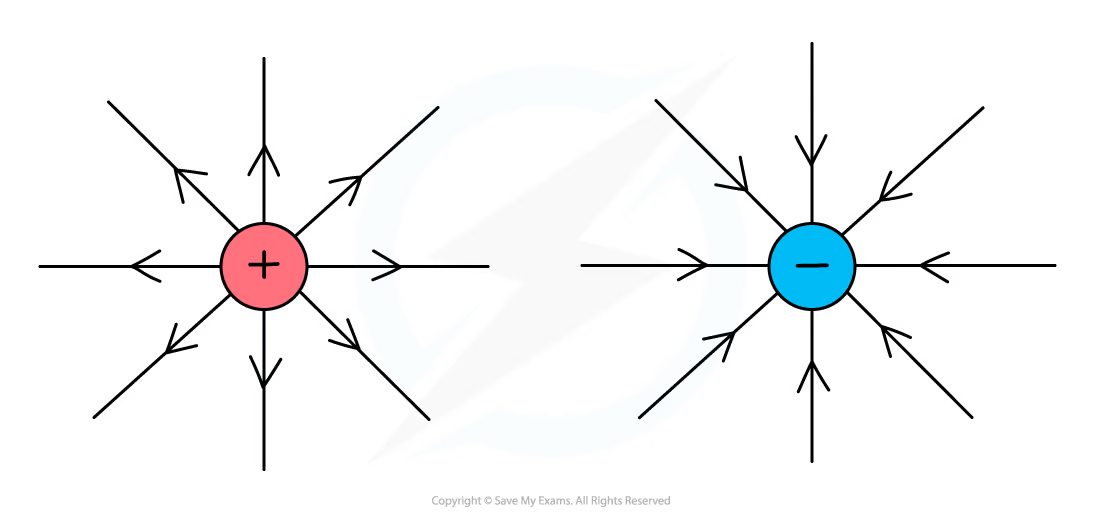
What does the strength of an electric field depend on?
The distance from the object creating the field
Field is strongest as the distance between the 2 charged objects decreases
What force do objects with the same type of charge (like charges) experience?
Repulsion
The 2nd charged object will move away from the charge creating the field
What force do objects with different types of charge (opposite charges) experience?
Attraction
The 2nd charged object will move toward the charge creating the field
What happens to repulsive forces as like charges move further apart?
They decrease
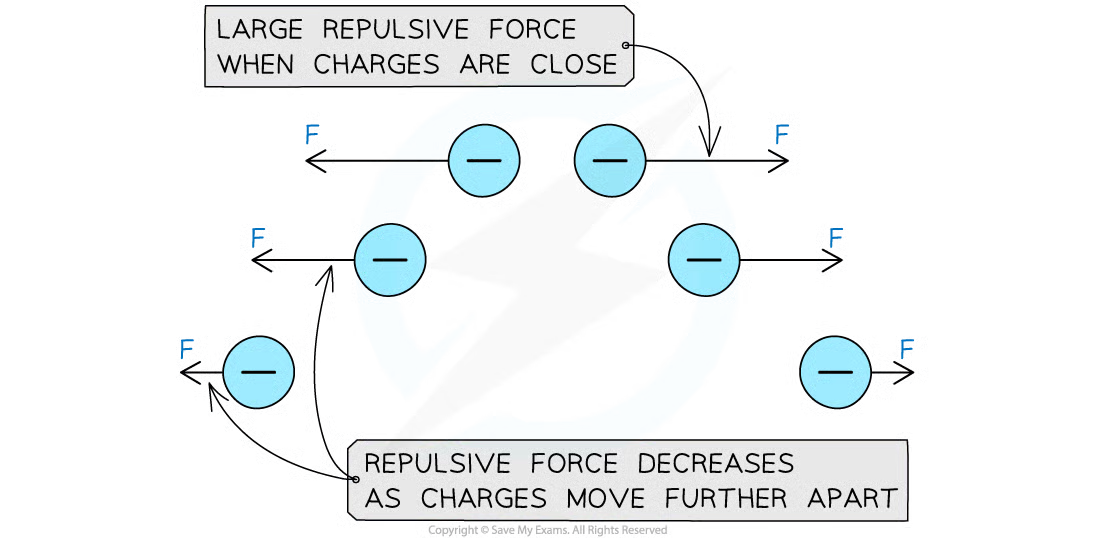
Why are metals good conductors of electricity?
Electrons can easily flow through them
Static electricity
The stationary electric charge produced by friction between insulators caused by the imbalance between negative and positive charges in two objects
Applies to solids, liquids and gases
How is static electricity produced?
By rubbing surfaces which causes insulators to become charged by friction
How does static electricity work?
All objects are initially electrically neutral
When electrons are transferred, one object becomes - charged and the other + charged
The difference in charges leads to a force of attraction between itself and other neutral objects
Why does static electricity only work for insulators and not conductors?
In conductors, the charge will move through them instead of remaining stationary
Explain static electricity in sticking a balloon to the wall
Rubbing a balloon on a woolen jumper transfers electrons onto the balloon by friction
The balloon is now - charged but the jumper is left + charged
The wall is still neutral, but when the balloon is placed near the wall, the + charges in the wall are brought to the surface because they are attracted to the - charge of the balloon
Since opposite charges attract, the balloon sticks to the wall from the electrostatic attraction
Why is static electricity more common in dry air conditions?
It is much harder for the charges to dissipate so they build up instead
What causes sparkling
The build-up of electrostatic charge
When does sparkling/electric shocks occur?
2 objects which are charged by friction are now oppositely charged
Electrons in the air molecules between the objects, experience a force towards the + object
Some electrons are pulled out of air molecules by the force of a field
The electrons hit other air molecules and knock electrons out of them
This causes a small current to flow between the objects (spark)
How is lightning an example of sparkling
In a storm, clouds move over each other causing them to become charged when electrons are transferred between them
Since the ground is neutral, the negative charge jumps to meet the positive charges on the ground creating a big spark (lightning)
What does a circuit diagram show?
How components in a circuit are connected together
Standard circuit symbols
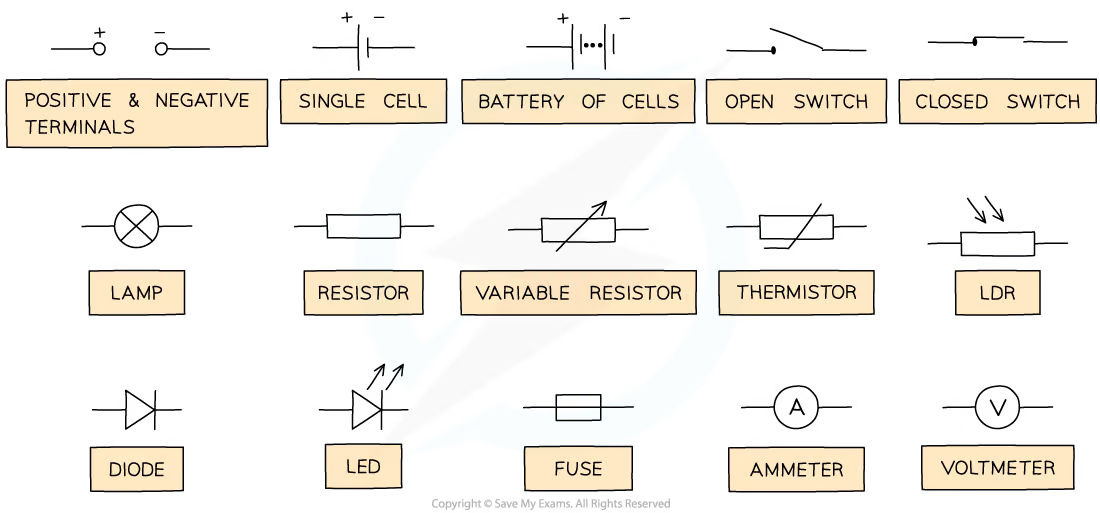
What and why does an electric circuit need to work?
An energy source – Source of PD so a current can flow
A closed path / complete circuit – Electrons need to flow in a complete loop for a current to flow
Electrical components – Perform a function
Electric charge
A group of electrons
Measured in Coulombs (C)
How many electrons are there in one Coulomb (C)?
6.24 × 10^18 electrons
Coulomb
The quantity of charge that passes a fixed point per second when a current of 1 A is flowing
What happens when a conductor is connected to a power source?
Electrons flow out of the cell and move around the circuit
The electrons are carrying energy from the cell
They pass energy to the components in the circuit like a lamp
In the lamp, electrical energy is transferred to light and thermal energy
When electrons return to the + end of the cell, they are carrying less energy than when they left the - end
Electric current
The flow of electrical charge per second
Measured in Amperes, amps (A)
Symbol for current is I
What direction does electric current flow in?
From the negative terminal of the cell to the positive terminal
What affects the size of current
The number of electrons passing through a component per second
Conventional current
The flow of positive charge from the positive terminal of a cell to the negative terminal
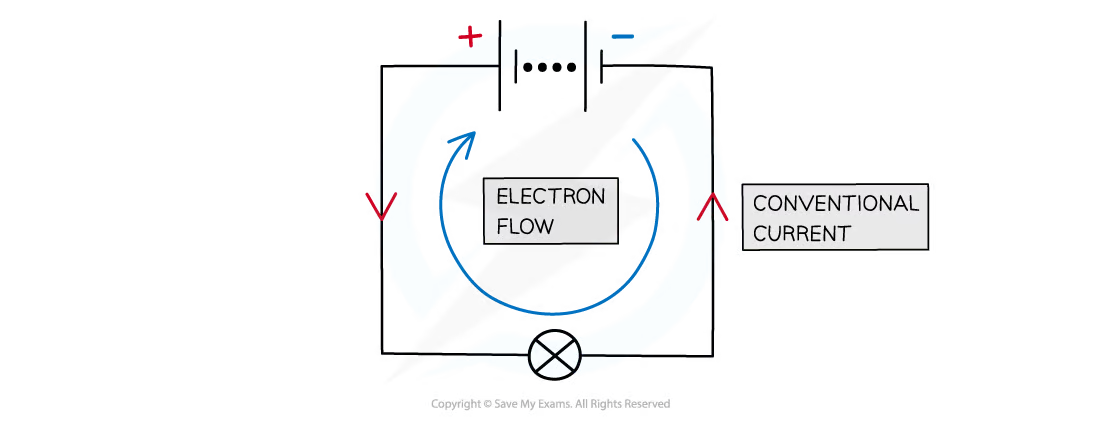
Why is the direction of conventional current opposite to the direction of electron flow?
Conventional current was described before electric current was understood
Equation for charge flow
Current, I x Time taken, t = Charge flow, Q
(amperes, A) (seconds, s) (coulombs, C)
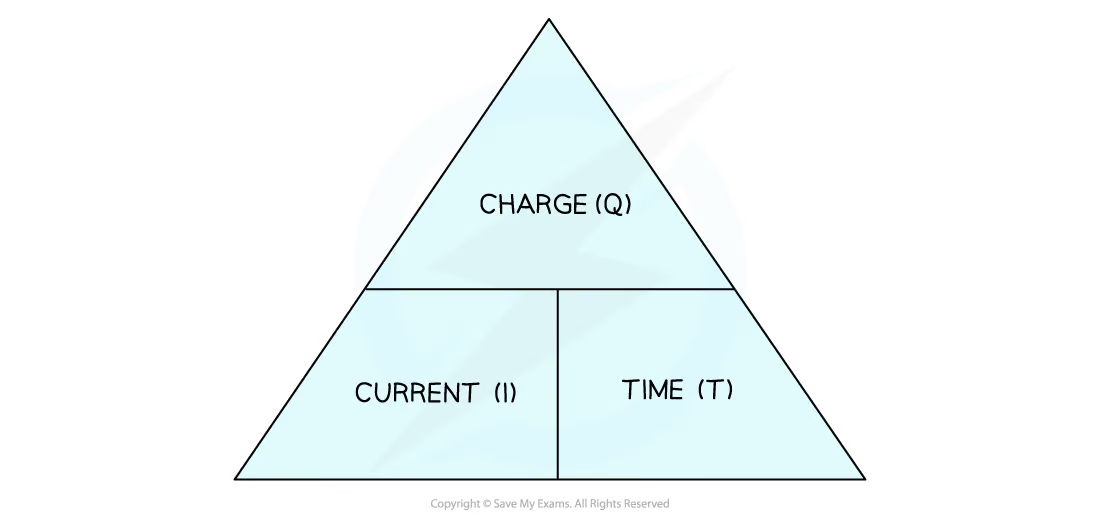
How is current measured in a circuit
Using an ammeter
How should an ammeter be connected in a circuit?
In series with the part of the circuit you wish to measure the current through

How and why does current behave in a series circuit?
Current is the same value at any point
The same number of electrons passes through each component every second
Series circuit
A circuit where current can only flow in one path
There are no branches
Current is never used up in a circuit
Parallel circuit
Contains branches so current can flow in more than 1 path
How does current behave in parallel circuits?
The current in the branches adds up to the total current leaving the cell
Potential difference (voltage)
The energy transferred per unit charge flowing from one point to another
Measured in volts (V)
Volts = Joule per coulomb (J C-^1)
What does a potential difference of 1 volt tell us?
1 joule of energy is transferred for each coulomb of charge moving through the circuit
Sources of potential difference
A cell
Batteries (multiple cells)
Electrical generator
How do you measure voltage
Voltmeter
How is a voltmeter connected in a circuit
In parallel to the component you are measuring the voltage for
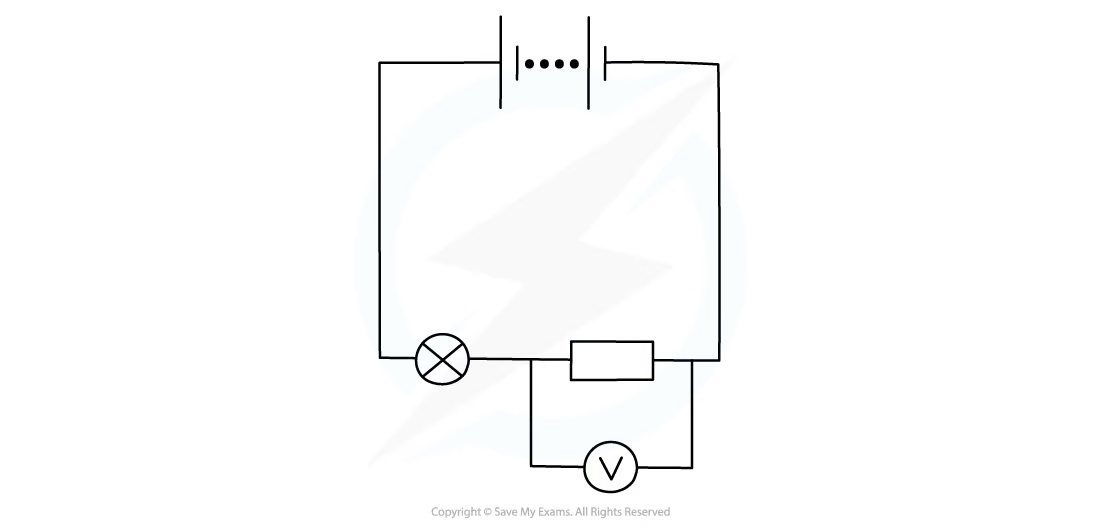
How does voltage behave in series circuits
The supply voltage is shared between components
Why are two lamps connected in a series circuit dimmer than if there were just only one?
The total energy carried by the current has been shared between the 2 lamps
If there was only one lamp, all of the energy carried by the current is transferred to that one lamp
How does voltage behave in parallel circuits
Voltage is the same as the supply voltage across components
Relationship between voltage and energy transferred to a component
The bigger the voltage, the more energy is transferred
Equation for energy transferred
Charge (Q) x Voltage (V) = Energy
(coulombs, C) (volts, V) (joules, J)
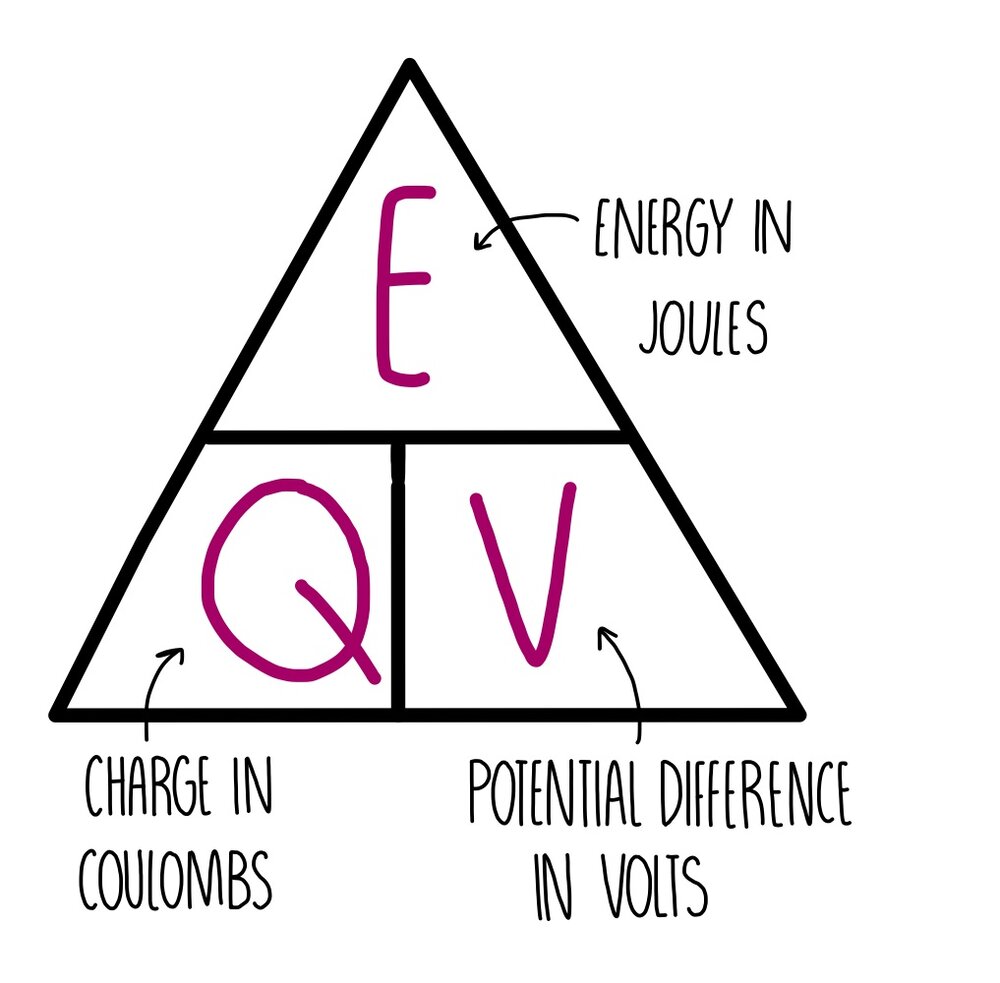
Battery
2 or more cells connected together
The cells in a battery must be connected in the same direction (eg positive ends both pointing to the left)
Resistance
The potential difference needed to drive a current through a component
Measured in ohms, Ω
Ohm= one volt per ampere
What factor about components causes them to transfer energy and why?
Resistance
As current moves, electrons collide with atoms in the metal
Electrical energy is transferred into other forms (like thermal)
Equation for the resistance of a component
Potential difference, V (volts, V)
--------------------------------- = Resistance, R (ohms, Ω)
Current, I (amperes, A)
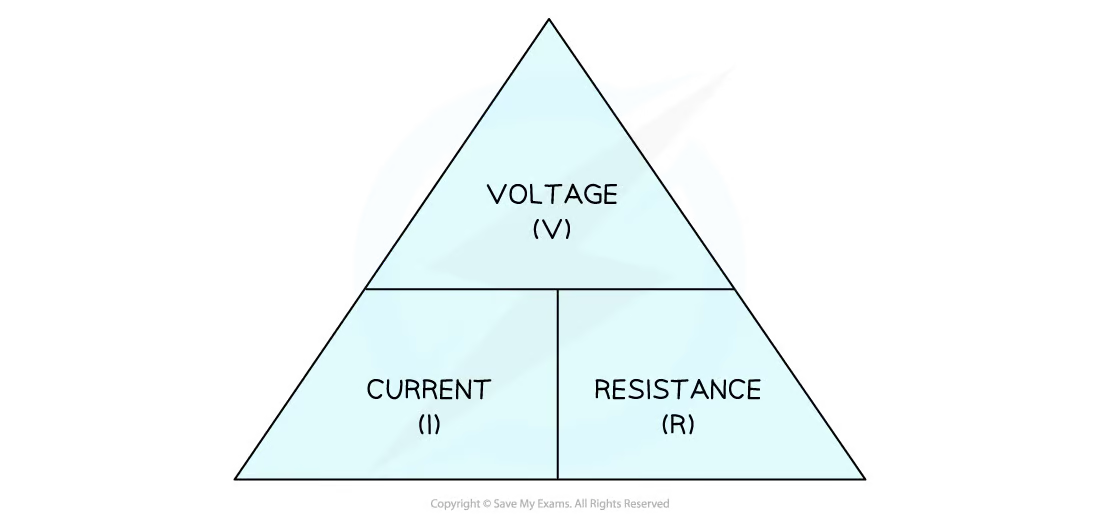
How does resistance affect current?
The higher the resistance of a circuit/resistor, the lower the current
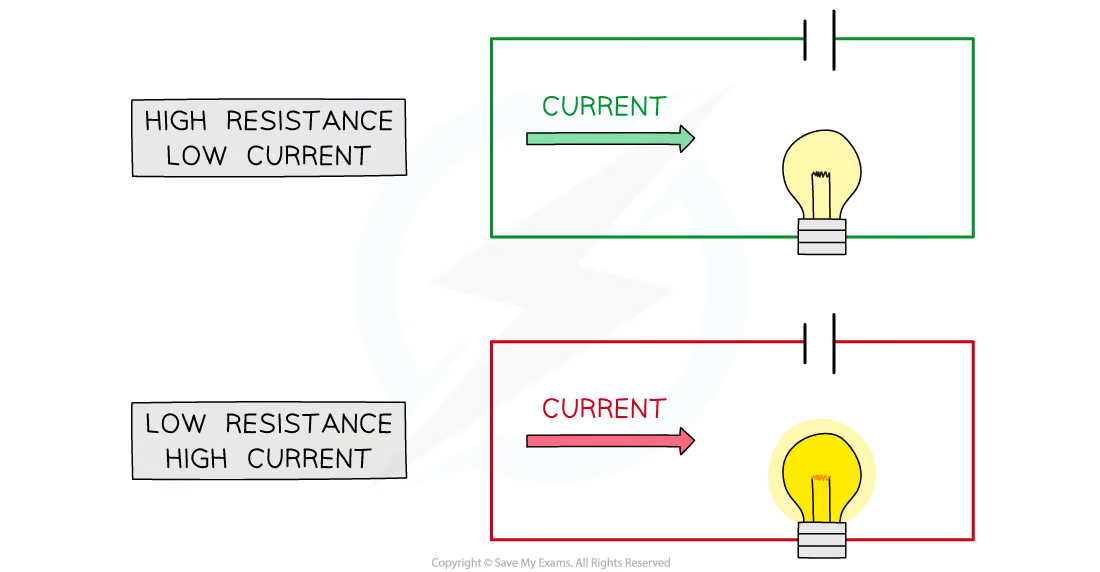
Do conductors and insulators have a high or low resistance?
Conductors: Low resistance
Insulators: High resistance
Why does adding resistors increase resistance in a series circuit?
The total voltage is shared between more resistors, which makes the voltage across each one of them less than before
The current through the resistors is hence less than before
As the total voltage is unchanged, the total resistance is greater
Resistor
A device that limits the flow of electrical current in a circuit
2 types of resistors
Fixed resistors
Variable resistors
Fixed resistor
They have a resistance that remains constant
Variable resistor
They can change the resistance through the circuit
Hence they can vary the amount of current through the circuit
Ohm’s Law
The current through a resistor at a constant temperature will be directly proportional to the potential difference across the resistor
If V and I are directly proportional, this means that the resistance R remains constant
The smaller the voltage the higher the resistance!!
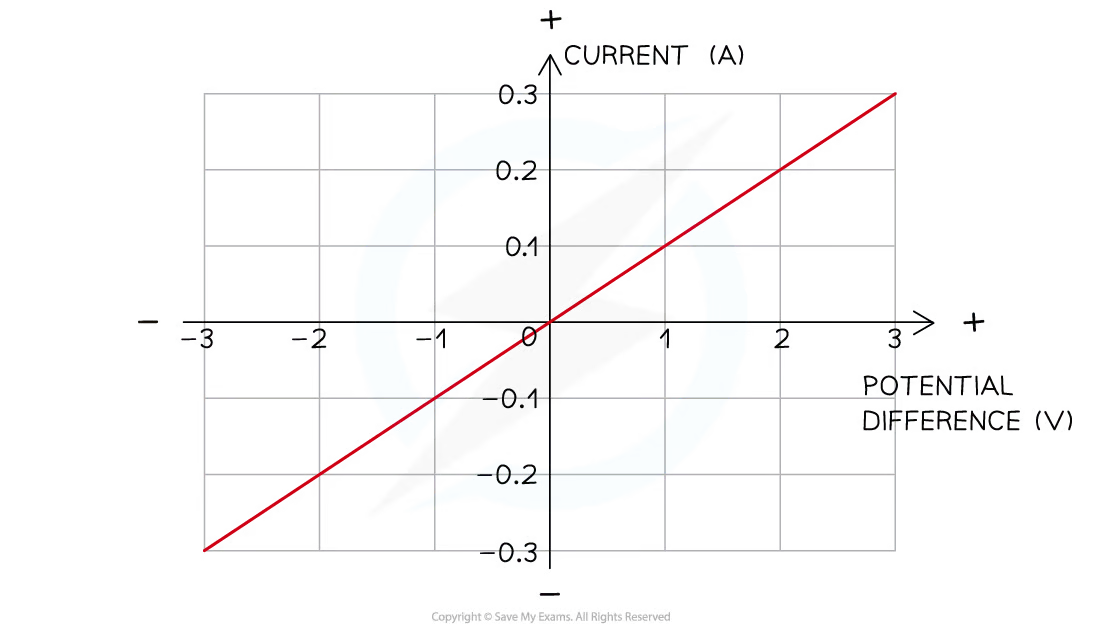
What happens if you reverse the potential difference, and hence the direction of current, across a resistor?
It makes no difference to the shape of the line (the values are just negative)
The resistance is the same in whichever direction the current is in
What does the gradient of the line depend on?
The resistance of the resistor
The greater the resistance of the resistor, the less steep the line is
Ohmic conductor
Components (resistors) that follow Ohm’s law
Fixed resistors, wires, heating elements
How do resistors in series behave and why?
The total resistance of 2 (or more) components in series is equal to the sum of the resistance of each component
Current has to pass through each resistor in turn
It can’t bypass any resistor
The more components the charge has to travel through, the higher the number of collisions that occur
How do resistors in parallel behave and why?
The total resistance of two (or more) resistors in parallel:
Is less than the resistance of the smallest individual resistor
This is because the charge has more than one pathway to take, so only some charge will flow along each path
The more pathways there are, the smaller the amount of charge in each path
How can you control the potential difference across a component using a variable resistor?
It contains a long piece of wire and a coil
Using the slider, we can change the length of the wire the current runs through
Increase the length of the wire → increases resistance → less PD flows through the wire
Factors affecting resistance and why
Thickness, length, temperature
Thicker wires = lower resistance because moving electrons have more space to move
Shorter wires = lower resistance because moving electrons have a shorter distance to travel
Hot wires = higher resistance because metal particles move faster and so electrons collide more with them
How does a filament lamp work?
The tightly coiled wire gets very hot when an electric current passes through it which causes it to glow and give out light
Why is a filament lamp a non-ohmic conductor?
Current and PD aren’t directly proportional
The filament gets hot so the resistance of the filament lamp increases
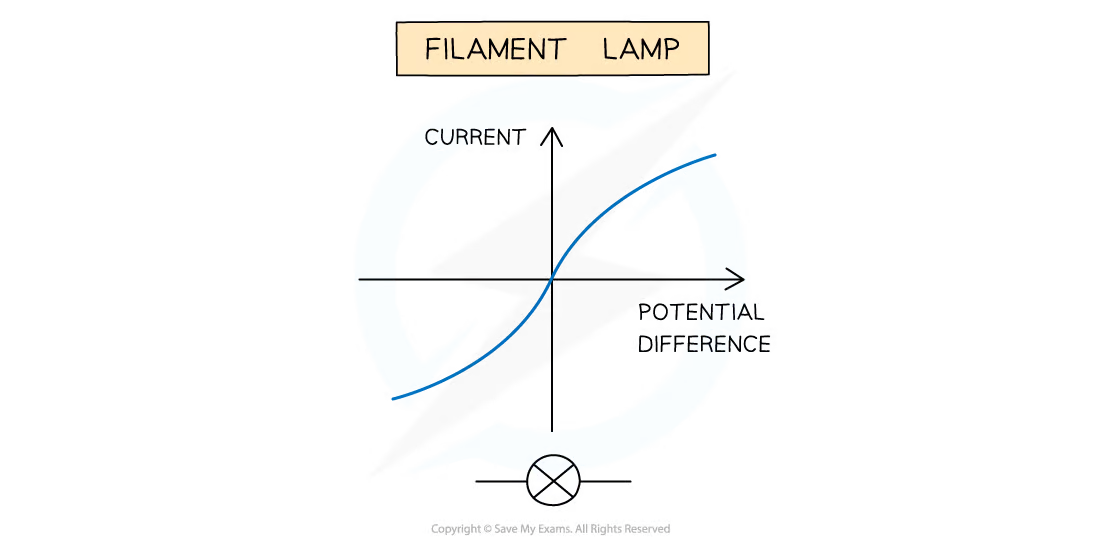
What does the IV graph for a filament lamp tell us?
Where the graph is a straight line, the resistance is constant
The resistance increases as the graph curves
Reversing the PD doesn’t make a difference to the shape of the line
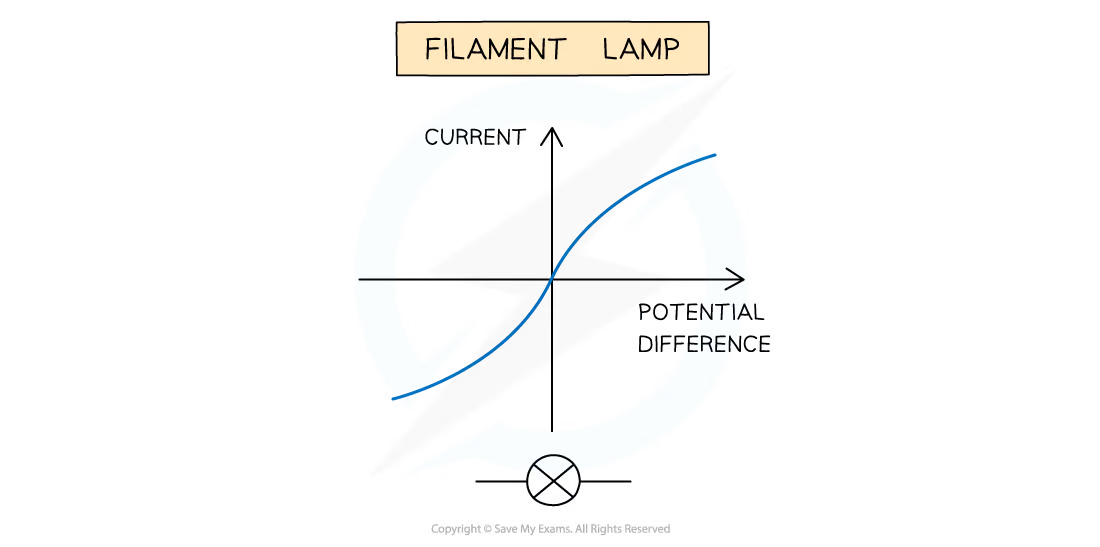
Why does the IV graph for a filament lamp show current increasing at a slower rate than the voltage?
As the current increases, the temperature of the filament in the lamp increases
Higher temperature → atoms in the metal lattice of the filament vibrate more
So resistance increases
Resistance opposes the current, causing the current to increase at a slower rate
Why will an increase in temperature cause an increase in resistance?
The higher the temperature, the faster atoms in a solid vibrate
The electrons collide with the vibrating atoms which impedes their flow
So current decreases, but resistance increases
Diode
A non-ohmic conductor that allows current to flow in one direction only (forward bias)
Why can current through a diode only flow in one direction only?
The diode has a very high resistance in the reverse direction (current is virtually 0)
Called reverse bias
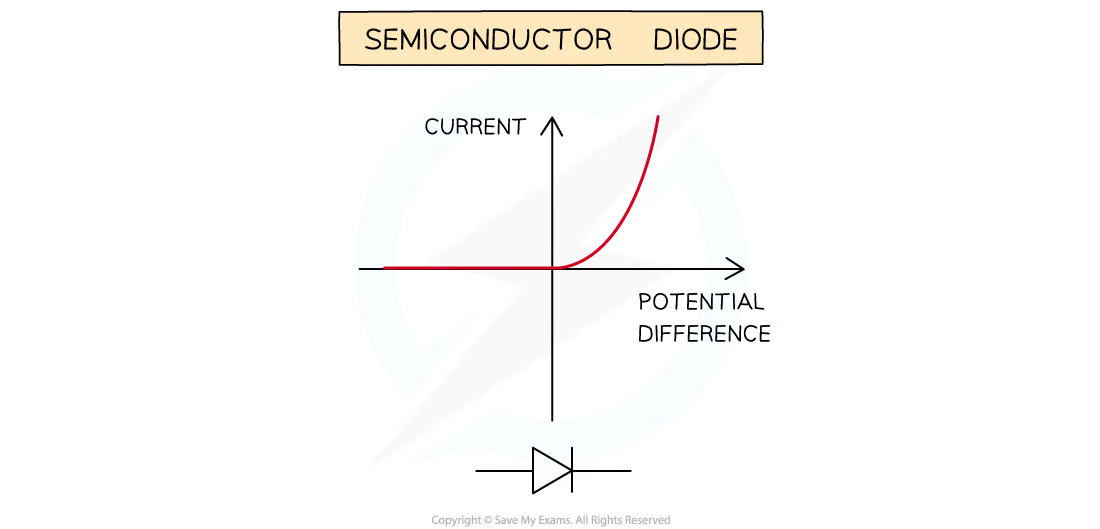
What does the IV graph for a diode tell us?
No current can flow in the reverse direction
In the forward direction, current increases as potential difference increases
What are diodes useful for?
Controlling the flow of current in circuits
Light-emitting diode (LED)
A diode that gives off light when a current flows through it in the forward direction
Very energy efficient source of light
Examples of non-ohmic conductors
Filament lamps
Diodes and LEDs
LDRs
Thermistors
Thermistor
A temperature-dependent resistor
It is non-ohmic
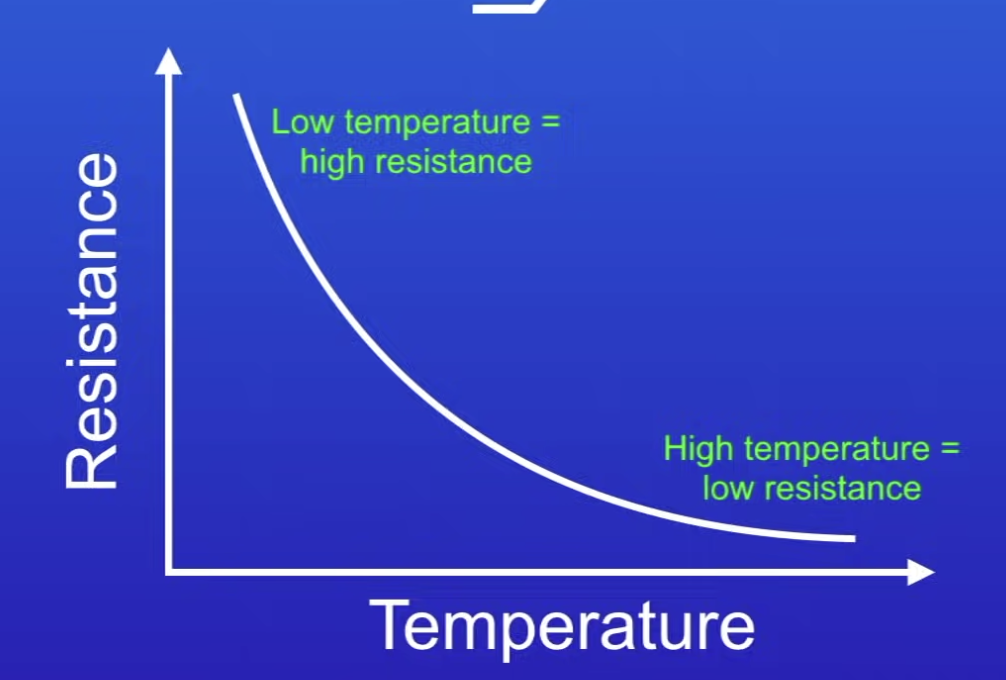
What happens to the resistance of a thermistor as temperature increases?
As the temperature increases the resistance decreases
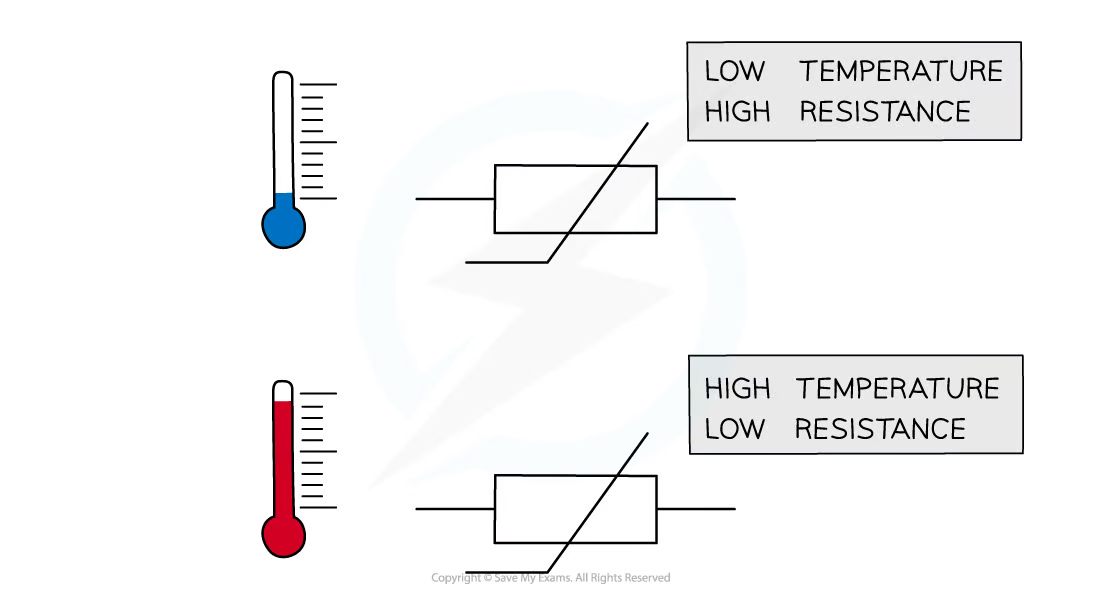
Why is a thermistor used as a thermostat?
It is a temperature sensor
It automatically regulates temperature or activates a device when the temperature reaches a certain point
Where can thermistors be found?
Ovens
Refrigerators
Fire alarms
Digital thermometers
Boilers
LDR
Light-dependent resistor
Non-ohmic conductor
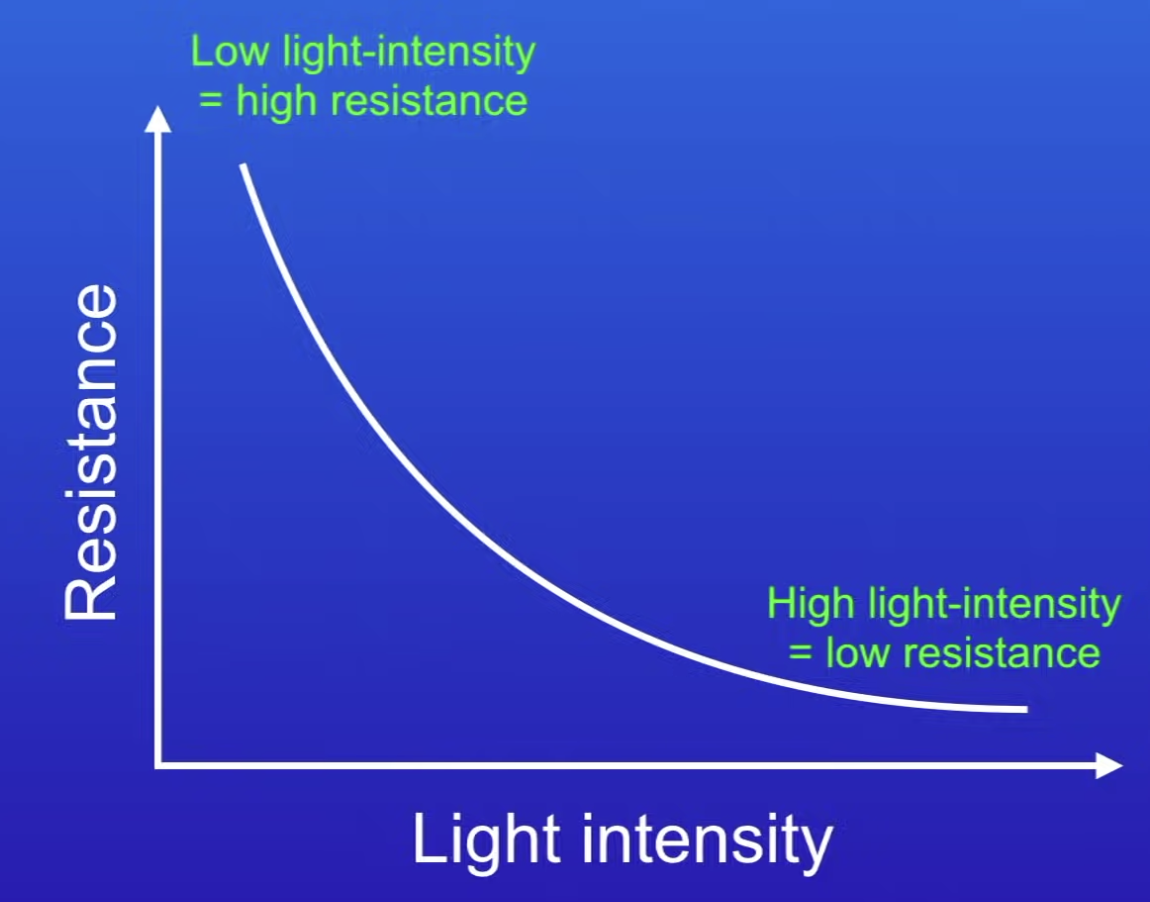
What happens to the resistance of an LDR as light level increases?
As the light intensity increases the resistance decreases
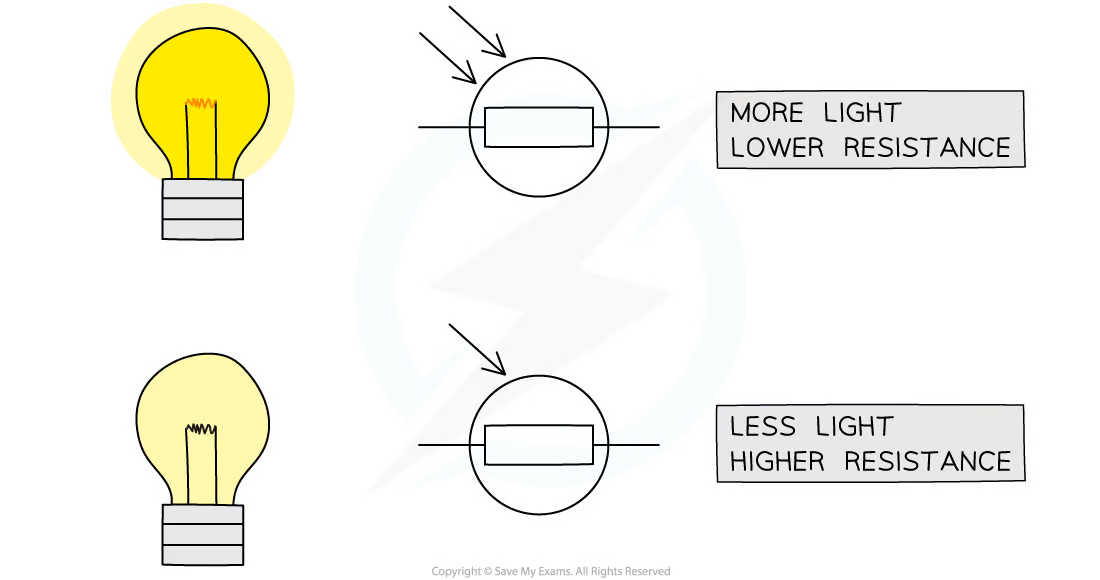
What can an LDR do as a light sensor?
It automatically regulates the amount of light intensity on it
It activates a device when the light intensity reaches above or below a certain point
Advantage of using LDRs
The circuits are automatic and don’t need any human time to function correctly everyday
How do cells behave in series circuits?
The total potential difference of cells in series is the sum of the potential difference of each cell
Why does adding resistors in parallel decrease the total resistance?
This happens because each extra resistor creates an extra path along which the charge can flow
This allows more charge to flow overall
This leads to a smaller overall resistance
Advantages of parallel circuits
Components can be individually controlled, using their own switches
If one component stops working the others will continue to function
Disadvantages of series circuits
If a components breaks, all of the others will stop working
The components cannot be controlled (switched on and off) separately